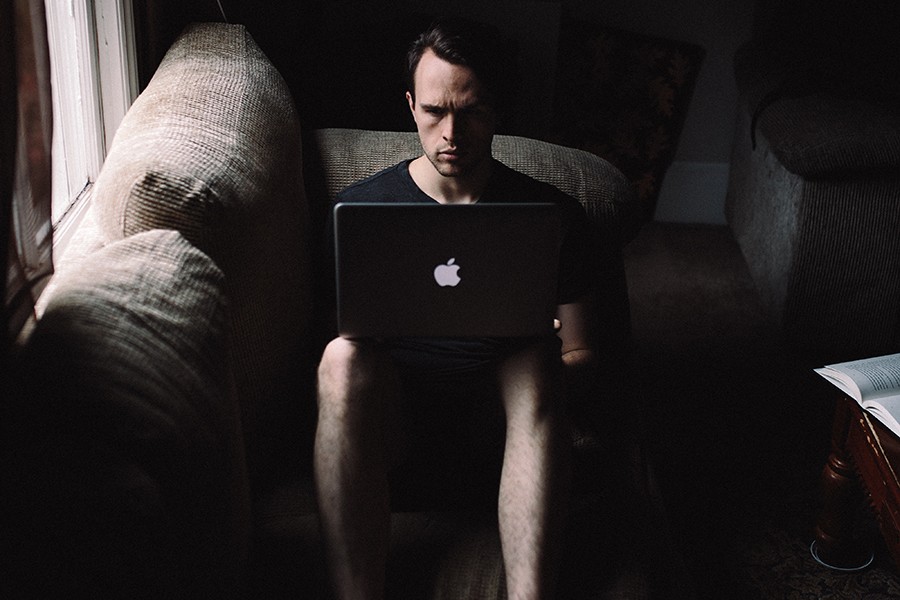Nikola Stepić works in the fields of Film Studies, English and Art History. His current research deals with the city as both a readable interface of desire and sexuality, and as a set of technologies that contribute to the formation of sexual identity. Nikola has published and presented widely on his interests in gender and sexuality studies, material cultures of masculinity, popular culture, porn studies and HIV/AIDS. His work can be read in Angelaki Journal of the Theoretical Humanities, the European Journal of American Studies, The Journal of Religion and Culture and others. An international student from Serbia, he resides in Montreal.
Blog post
What porn can teach us
 Credit: Andrew Neel/Unsplash
Credit: Andrew Neel/Unsplash
There is a particular kind of reaction one gets when they mention that their academic work deals with porn.
Eyebrows tend to raise, heads have a way of tilting. The picture speaks a thousand words. It might mean that the uninitiated find the topic unseemly, something that belongs only in one's Internet search history before the browser is swiftly purged with a click of a button, and certainly nowhere near academia.
Others might find it amusing but pointless – why study something that we all inherently "get"? And for many, the admission reads as a coming out story: that I spend time looking at, thinking about and discussing X-rated materials with other aficionados.
While porn studies is a rich and populated field, rising out of the debates on pornography by second-wave feminists in the late seventies and early eighties, and given shape by such academic legends as Linda Williams, Gayle Rubin and Concordia's own Thomas Waugh, there is still some distrust, if not outright judgement, one needs to be braced for.
In fact, a seminar by and for researchers in the field of Adult Film History at the last Society for Cinema and Media Studies conference, the biggest of its kind in North America, confirmed in no uncertain terms that pornography's capacity to titillate, shock and cause discomfort often extends into the experiences of the genre's historians.
So how can porn be useful, you may ask? Here's a few considerations worth keeping in mind.
The Aesthetics of Porn
There are no easy solutions to the perennial question about the distinctions between art and pornography. What does it mean when art is "porned," or when porn is "artsy"? Andy Warhol's 1964 film Blow Job, in which he presents us with a thirty-minute close-up of an actor's face as he is receiving oral sex, is a great example. Are we to trust the smutty title, or is it all a ruse?
The film beckons us to think of our own position as spectators while keeping the action off-screen. On the other hand, honest-to-goodness porn flicks like Behind the Green Door and Bijou (both released in 1972) are sumptuous exercises in unbridled aestheticism and sensory overload, and stellar examples of what is known as the Golden Age of Porn or simply "porno chic."
The rise of hardcore art cinema in the late eighties and early nineties, with French film directors such as Catherine Breillat and François Ozon, further pushed the boundary in a new wave of films obsessed with human sexuality and its attendant power dynamics. Also dubbed "cinema of the body," these films notably violate the conventions of mainstream cinema by including copious amounts of nudity, non-simulated sex and transgressive social critique.
Across the pond, Torontonian Bruce LaBruce has consolidated the energy of the queercore movement in his unapologetically fetishistic works – from a homoerotic deconstruction of the skinhead figure in 1993's No Skin Off My Ass to 2010's L.A. Zombie, a porn-horror study of twenty-first century capitalism featuring porn superstar François Sagat.
 Credit: Elijah O'Donell/Unsplash
Credit: Elijah O'Donell/Unsplash
Pornography's Political and Material Circumstances
The frequent mobilization of pornographic tropes in "mainstream" cinema signals another important feature of the genre, namely its ability to be unflinchingly political. Here, I am not thinking solely of porn parodies – although works that satirize political figures from JFK to Donald Trump underscore the populist appeal of the genre.
The so-called "sex wars," or debates on pornography that were historically instrumental in the development of second- and third-wave feminist movements, have resulted in key works by feminist thinkers on the subjects of power, patriarchy and sexualized violence. And indeed, it was performers like Nina Hartley, Annie Sprinkle and, more recently, Erika Lust, who mobilized the genre in order to effectively advocate for safer sex, sex positivity and sex work, paving the way for the emergent markets of feminist and queer pornography. In this sense, what is arguably the most popular of popular cultures becomes an interface of social change that allows us to study sexual cultures and representation within wider activist and political frameworks.
Moreover, looking past the on-screen "action" oftentimes allows us to study the material circumstances of the films. As porn theorist Whitney Strub has argued, 1970s porn set in New York City reacted to that decade's urban crisis, but whereas straight hardcore films served as cautionary tales on the dangers of the city, their gay counterparts recast the under-surveilled New York as a queer playground, relishing in the post-Stonewall display of sexual identities.
As Strub notes, "These are films about gay men enjoying themselves in public." ¹ Scholar Jeffrey Escoffier goes a step further, arguing for pornography as an object of research for studying the history of sexuality, effectively treating hardcore films as documentaries. This is a somewhat radical notion, but it's undoubtedly true that porn offers a visual history that is ripe for analysis for those interested in how gender and sexuality intersect with architecture, geography, fashion and interior design.
Like other genres of "low culture", such as romance novels, reality TV or YouTube, porn is always regarded with some suspicion. Yet, it is clear that sometimes it is these quotidian genres – the ones that are all around us and that oftentimes we consume without thinking – that offer us some of the most valuable insights into what society considers beautiful, empowering or insightful. If you need further proof, just check out these fun insights from the XXX behemoth itself, PornHub, which tracks porn use around such events as the Game of Thrones finale, the Royal Wedding and on International Women's Day. Now, that's useful!
¹ Strub, Whitney. "From Porno Chic to Porno Bleak: Representing the Urban Crisis in 1970s American Pornography." Porno Chic and the Sex Wars, edited by Carolyn Bronstein and Whitney Strub, University of Massachusetts Press, 2016, 27-52.
About the author


